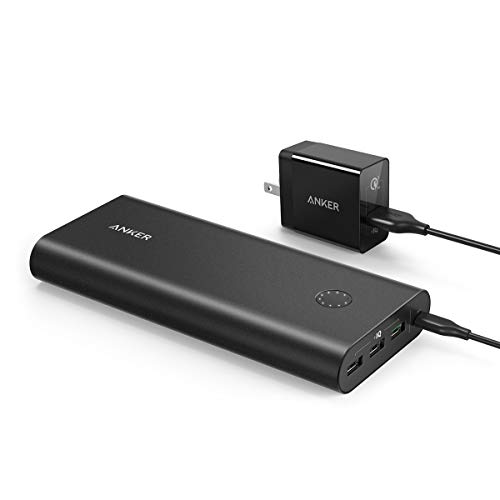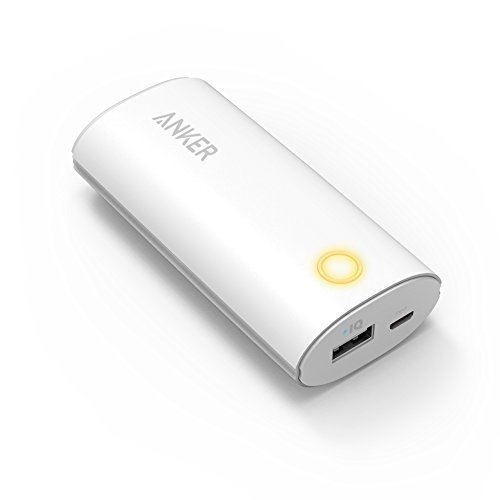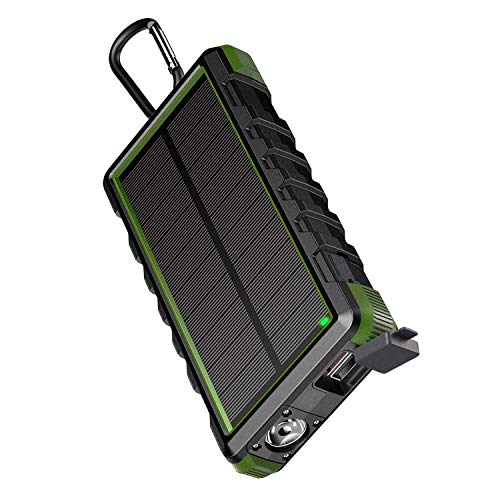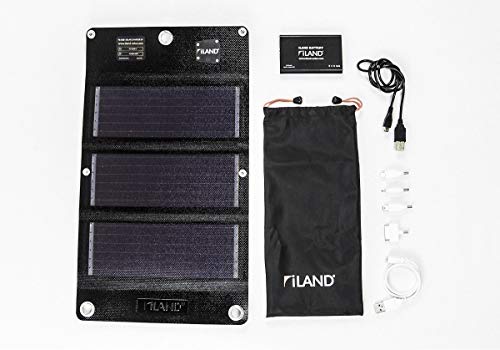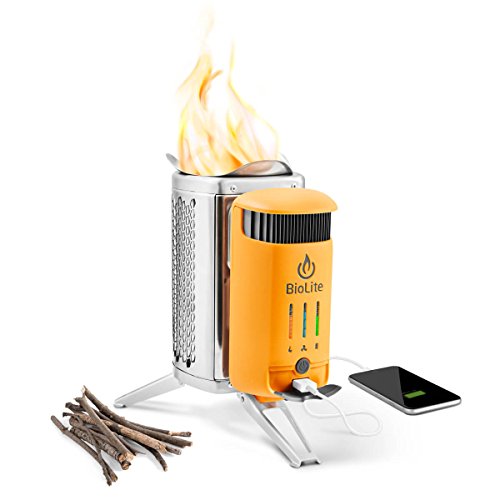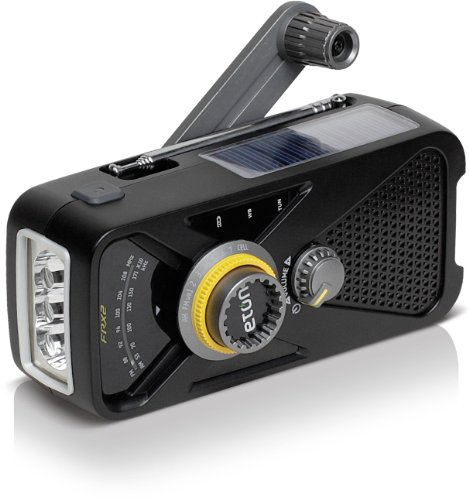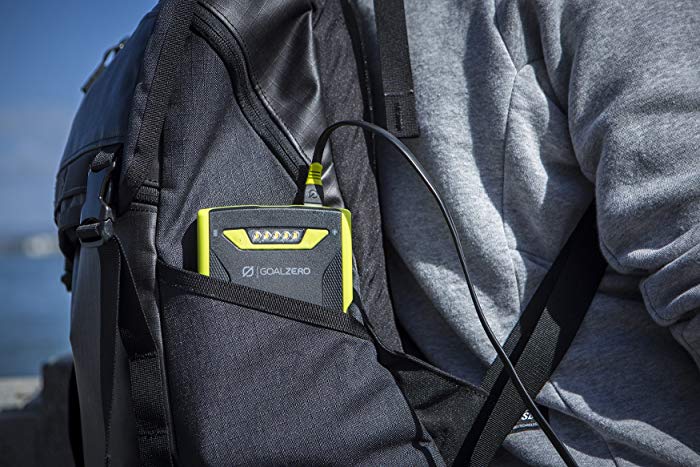
Updated December 2018
Whether you’re heading out for a month long expedition or camping overnight with the family, chances are you need power. Today more than ever it’s necessary to have access to supplemental power for charging phones, tablets, GPS, and other units.
More...
We’re going to take a look at some of the best portable battery packs for camping and backpacking. Some are waterproof, some are tiny. Others are in between or made for car camping.
Comparison Chart
Name | Price | Weight | Rating | Notes |
|---|---|---|---|---|
$$$ | 1.31 lbs | 10 iPhone charges, 7 Galaxy S7 charges and multiple charges for other tablets and devices | ||
$$$ | 4.8 oz | Charges the iPhone 6 well over two times, the Galaxy S6 1.5 times , and other smartphones multiple times. | ||
$$$ | 6.9 oz | charges the latest smartphone models iPhone X 1.5 times, iPhone 8 2.2 times, and Samsung Galaxy S9 1.3 times | ||
$$$ | 12 lbs | 168Wh lead acid battery portable power station can power up to 5 devices at once (14Ah @12V) | ||
$$$ | 19.3 oz | Waterproof. Dustproof. Shockproof: With an IP66 rating and rugged design, the power bank effectively resists water, mud or bumps in outdoor activities | ||
$$$ | 1 lb | Waterproof in use - spray it down, take it to the beach, leave it in the rain - and never worry about rubber plugs. | ||
$$$ | 1.17 lbs | SunPower Solar Panels with solar conversion efficiency of up to 23.5% | ||
$$$ | 8 oz | Shadow-tolerant, Amorphous Silicon Solar Panels | ||
$$$ | 2.65 lbs | Turns fire into electricity! CampStove 2 generates 3 watts of usable electricity and stores it in it's internal powerbank | ||
$$$ | 9 oz | Eton's compact, multi-purpose FRX2 Radio is a solar, DC battery, or hand turbine powered AM/FM/NOAA weather radio with a USB smart phone charger |
Do you need portable power when backpacking or camping?
When you are camping, is it worth bringing along portable power with you? Many outdoor purists will say “leave your electronics at home” and “it’s not camping if you have your phone with you.” Although it is important to take your eyes off the screen and connect with nature during your camping trip, your smartphone is actually a very useful item to have with you when you are camping.
You might think that having portable electrical power is only so that you can play Candy Crush on your smartphone or post photos of your campsite to your Instagram – but it’s more than that.
There are a lot of reasons to consider using a battery pack while you are out in the wilderness. Let’s take a look at the pros and cons.
Battery Pack Pros
Battery Pack Cons
With all of this considered, bringing a cellphone and a battery pack when you are camping is highly recommended. It’s there for you if you need it, but you can also switch it off when you want to live in the moment and enjoy the beauty around you.
How to Choose a Battery Pack
To help you choose we’ve outlined a few things to consider before purchasing:
Capacity
Most portable battery packs are measured in mAh that’s milliamp hours. Usually manufacturers or other reviewers around the internet have already converted this number into something more usable.
Who cares about mAh – what we really want to know is how many charges can I get on my new phone from this battery pack!? Check the manufacturers specifications for this information.
Generally, anything under 10000mAh will give about 3 smart phone charges. 20000mAh+ battery packs may provide 6-10 charges of a smart phone.
Size
Consider the bulk of your battery pack. As capacity and number of charges increase, so does bulk. For car camping, canoeing, or use around the house this may not matter as much.
If, however, you intend to hike or backpack with your portable battery pack, considering size is very critical. Backpackers who travel for many miles through the backcountry will pay close attention to every ounce of their backpack, so a bulky item like a battery pack will make a big difference.
Weight
Most battery packs are powered by dense and heavy modern batteries. These provide great charging capacity in tiny packages. They can, however, be deceivingly heavy so check the manufacturer’s specifications for weight before purchasing. High capacity chargers often weigh quite a bit, and it all adds up if you have to lug it around with you.
The weight doesn’t matter as much if you are camping with a car, or using your battery pack when you are living out of a motorhome or a van. In those situations, it’s possible to use a larger battery pack with more capacity, as you won’t have to be carrying it yourself.
Charging Ports
Consider the number of devices you may with to charge at one time. If you’ve got a whole family plugged in to their phones all weekend on a camping trip (get rid of the phones if you’re camping) then you may need multiple charging ports.
Most newer battery packs are coming equipped with rapid charging ports for devices and rapid charging ports for the battery pack itself. If you have a quick charging smartphone you may want to ensure your battery pack has the appropriate output to keep up. Are each of the ports rated for the device you are plugging into it?
There’s often a maximum power output across all USB ports, which means that if you plug in more than two or three devices at a time, charging will slow down for all of them.
There are some battery packs that will be able to charge laptops, but they tend to be very large, heavy and expensive. So, they are likely not what you want. The chances are – you will only be bringing your laptop with you if you are camping with a car, or living a nomadic lifestyle out of a motorhome or van.
Type of Power
The type of power your battery pack uses is also an important factor to consider. Solar powered battery packs are hot right now, but they aren’t necessarily the best option for every location. In many locations, battery power is more reliable.
The best way to choose the right type of power is to consider the climate of your hiking terrain. If you can count on a lot of sunshine and you’ll be camping for a long time, solar power is a good choice for you. If not, you might consider a chemical charger.
You might also want to look into thermal devices, if you plan to do a lot of cooking or lounging by the campfire. These types of devices are designed to turn the heat of the fire into battery power – and they also do double-duty by cooking your food at the same time.
The 10 Best Battery Packs
If you’re going camping and weight or bulk are not an object then this beast of a battery pack is for you!
Looking for a battery pack for camping that can charge your phone, tablet, small laptop, and phone again all on one battery? We’re pretty sure you’ll find it hard to beat the Anker Power Core+ 26800.
This awesome charger feature brand new Qualcomm Quick Charge 3.0 tech to rapidly charge your devices, and even recharge the battery pack faster. Charge your 2015 MacBook up to three times and simultaneously charge up to three devices. This is what makes the device really useful for digital nomads and those who live the “van lifestyle.”
If you’re going on a hardcore sasquatch hunting, geocaching, expedition you’ll have plenty of juice for the GoPro, GPS, and laptop. Or, for those of us feeling less adventurous, there’s plenty of juice for long flights, weekend camping, or road trips!
OTHER USEFUL INFO | |
|---|---|
Best For | High Capacity Portable Charging |
Max iPhone Charges | 10+ |
Size | Large |
My personal choice for a portable backpacking battery pack. I like to carry this on trips where I may be using my phone for maps (AT) or where I may want cell connection in a less remote area.
Many wilderness areas these days have cell reception and for many reasons, backpackers may wish to carry and charge a phone. As discussed above – your smartphone has a lot of uses in the backcountry and it’s also simply a safety precaution to have it with you.
Rated to charge the iPhone 6 over two times, I found that the Anker Astro would easily charge my iPhone 5 2-3 times. With light use, airplane mode when reception isn’t necessary, and a little planning I can easily make my phone last for up to two weeks of careful use with this battery pack.
Charge is measured by a shake-sensitive light on the front with no external buttons. I found that even inside my backpack, where the external indicator light would almost always be on from sensing shaking, it seemed to have no impact on the life of the battery.
OTHER USEFUL INFO | |
|---|---|
Best For | Supplemental Power Backpacking |
Max iPhone Charges | 2+ |
Size | Compact |
This RAV Power battery pack is a direct competitor to the Anker Astro. In size, shape, and capacity we have nearly identical devices. However, there are the differences:
The RAV Power 7600mAh battery pack is quite inexpensive. At only $15 this battery pack comes in as one of the least expensive options. Still able to produce up to two charges of a smartphone in a small package.
Power meter is controlled via a small button which solves my biggest complaint about the Astro. Quick charge ports are identical across both devices.
Overall the RAV Power 6700mAh gets high marks for low price, great features, and slight refinements over the Astro. A sure competitor that would have me struggling to choose the best.
OTHER USEFUL INFO | |
|---|---|
Best For | Supplemental Power Backpacking |
Max iPhone Charges | 1+ |
Size | Compact |
To find out what devices this will charge, you’ll need to understand the power consumption of your devices and compare it against this handy chart and tech specs from Goal Zero.
This battery pack has the option of being charged by solar panels also sold by Goal Zero so if you’re going to be staying in one place, perhaps extended car camping or primitive living, this is the pack for you. Goal Zero tossed a 33Wh battery in here which is orders of magnitude large (in charging capacity) than anything else we have listed.
If you need more power than this, Goal Zero makes larger battery packs which also can be charged via solar panel. These devices are much too large and heavy to be carried so use them only for car camping or remote living.
OTHER USEFUL INFO | |
|---|---|
Best For | Car Camping |
Max iPhone Charges | Too many to count |
Size | 7.8 x 6.8 x 5.8 inches |
While perhaps not light enough to justify regular backpacking use, the EasyAcc is durable and waterproof. IP67 rating can be immersed in 1 meter of water for up to 30 minutes. This battery pack is also surrounded by thick rubber casing for shock and fall protection.
Users rave about it’s bombproof design and aesthetic. With a covered charging port, LED flashlight, and intuitive charge meter, this battery pack makes a strong case for camping and backpacking. It would be a handy device to have if you are exploring in inclement weather, or if you are doing something wet and adventurous such as whitewater rafting.
Manufacturer claims up to 7 charges of an iPhone 6 on just one full battery pack charge. For the weekend warrior or aggressive backpacker, this might be a good choice. Bombproof construction and high capacity for a portable charger make this a contender!
OTHER USEFUL INFO | |
|---|---|
Best For | Best for Technical Outdoor Activities |
Max iPhone Charges | 7+ |
Size | Medium |
This battery pack, from Goal Zero, comes equipped with two USB ports for charging multiple devices at once and also has a built-in flashlight. It offers 19,200 mAh of power and has a rugged case that is IP67 certified dust-proof and waterproof.
That means that even if you dunk it in a river or use it in the pouring rain, it will still work. In fact, you can even use it when it is wet – you don’t have to worry about drying it out.
The two ports are capable of dishing out the fastest possible charge – even when you are using them both at the same time. Plus, it also offers you the option to use the solar panel – you can get a full charge out of the battery after 12 hours of sunlight.
OTHER USEFUL INFO | |
|---|---|
Best For | Wet Weather Backpacking |
Max iPhone Charges | 7 |
Size | Medium |
The AUKEY does a really good job for a cheap solar charger. It has a high efficiency rate and it enables you to charge more than one device at a time – quite quickly. The solar panels have a solar conversion efficiency of up to 23.5% and the dual USB ports will detect and adapt to your USB powered devices in order to provide you with the fastest possible charging speed.
Plus, this charger offers a foldable design for easy transport – which makes it great for long distance hiking. You can fold it up and the thin profile doesn’t take up a lot of room. It is water and weather resistant and the solar panels are made with high-wear PVC fabric.
It’s also possible to strap the device to your backpack so that you can charge it while you are hiking – although this can be a little bit awkward and bulky.
OTHER USEFUL INFO | |
|---|---|
Best For | Camping in Sunny Climates |
Max iPhone Charges | Depends on the Sunlight |
Size | Medium, a bit bulky for backpacking – better for camping |
This device is a flexible 65 square inch silicon panel that charges a 2.10 mAh battery. (The battery capacity is measured in milliampere-hour.) The advantage of the iLAND FLY is that it is very light and it is slightly more durable than other batteries – such as the Goal Zero Guide 10. It is built to military grade specifications – which means that it is water, dust, temperature and shock-resistant.
The Fly has a built in USB port, so it can be used to charge all kinds of devices. You can use it with your iPod and iPhone, and it will also work well with a digital camera as well. It doesn’t hold enough charge for a large device, but for small gadgets it will work well.
However, one of the disadvantages is that it can take a while to charge. It charges in full sun in 9 hours, or 11 hours if it is cloudy. So, this means that if you plan to charge it, you’ll need to have a rest day where you stay put at the campsite.
OTHER USEFUL INFO | |
|---|---|
Best For | Camping in Sunny Climates |
Max iPhone Charges | 1 |
Size | Small |
Imagine if your campfire not only warmed you up and cooked your food – but it charged your phone as well. The BioLite Campstove burns wood and generates a smokeless fire that can boil water in minutes, while also turning its heat into electricity.
Plug your phone into the USB output and the device will generate 5V of power to keep you connected. The heat is generated into electricity via a thermoelectric generator, which powers a fan and sends electricity to a USB charging port. There’s also an internal fan that injects air back into the burn chamber, which helps to improve combustion and makes the fire burn faster and more efficiently.
Then, the power is stored within the on-board battery which can then be used to charge your devices without a live fire.
This is certainly not the lightest or most compact of the devices on this list. It weighs two pounds, so it might be something handy to bring along on a car camping trip but you wouldn’t want to bring it on an ultra-light long distance backpacking journey.
OTHER USEFUL INFO | |
|---|---|
Best For | Ideal for Car Camping or Remote Living |
Max iPhone Charges | Depends on how long you keep the fire burning! |
Size | Compact |
One of the advantages of using hand turbine power is that it is infallible. You’ll always be able to generate more power, as long as you keep turning the crank. Your arms might get tired, but your phone will always be charged! Also, it only weighs 3.2 ounces, so it won’t be very heavy if you are backpacking long distances.
This is a great device to have with you because no matter what happens, you’ll always have access to power. A minute of cranking will give you enough power for around four minutes of talk time, as well as a few critical texts if you need them.
Of course, the cranking can be tiresome – so you might want to save this device as a backup for when you absolutely need it.
OTHER USEFUL INFO | |
|---|---|
Best For | Hikers with Strong Arms |
Max iPhone Charges | 1 |
Size | Medium |
Conclusion
If you’re looking for slim, portable battery packs for backpacking or every day carry then these are the packs for you:
If, however, you live a nomadic or car-based lifestyle you might consider:
For avid backpackers I would recommend lighter, smaller, and more compact. For campers weight and bulk isn’t nearly the issue so any of our battery packs would make sense!
When choosing a battery pack consider the number of people and devices using the pack as well as the duration over which you will need the battery pack to last. What are you hoping to charge, and how many times?
These are critical choices to make before purchasing. Take your time and do your research – when you find the right battery pack it will be an essential item that will improve your life on the trail.

